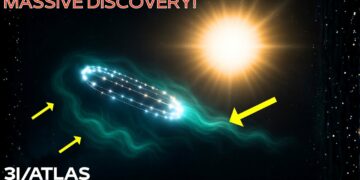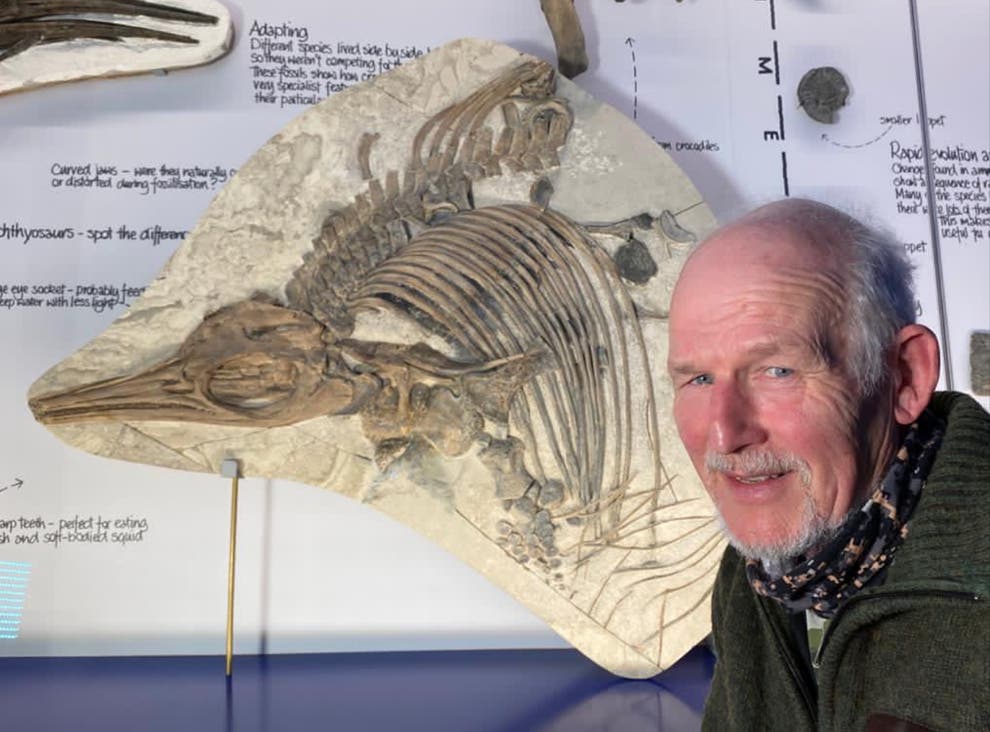December 15th, 2025. The day 3I Atlas will pass closer to Earth than any interstellar object in recorded history. Across the planet, hundreds of observatories are on high alert. Telescopes in Hawaii, Chile, and Spain have been tracking its approach for months, and each new image reveals something more disturbing than the last.
What began as a faint green speck beyond Jupiter has become a cosmic event that could rewrite everything we thought we knew about the laws of space. Scientists are now divided into three camps:
- Some believe 3I Atlas will simply glide past and vanish forever into the void.
- Others warn that its bizarre chemistry – rich in nickel yet almost devoid of iron, with a confirmed 8:1 carbon dioxide-to-water vapor ratio (measured by the Keck Observatory) – could trigger unpredictable energy reactions as it crosses Earth’s magnetic field.
- And then there are those who fear something far stranger: that it might emit a signal… or even respond to one.
Because ever since 3I Atlas entered the Sun’s sphere of influence in October 2025, physics has stopped making sense. Its tail turned backward against the solar wind. Its velocity began to fluctuate like a living pulse. Something out there is not following the rules. And on December 15th, it is coming straight toward us.
It began on the outer edge of the solar system, far beyond Neptune, where sunlight fades into silence. In early 2025, a faint emerald glow appeared in data from the Pan-STARRS observatory in Hawaii. At first, astronomers assumed it was just another interstellar comet passing through on its way out of the galaxy. But the more they studied it, the less sense it made.
Officially catalogued as 3I Atlas – humanity’s third confirmed interstellar object – it moved as though gravity barely touched it. It sliced through the outer solar system at nearly 150,000 mph, crossed Jupiter’s orbit, then Mars’, without slowing down. Its motion was unnaturally smooth, almost deliberate, as if guided.
For months, observatories worldwide collected data, and every new observation deepened the mystery. Its composition contained nickel vapor but no detectable iron – something that should not exist in nature. Its gases burned an eerie blue-green. And its tail did not behave like ordinary cometary dust or ice; it bent, pulsed, and shifted direction against the solar wind, like a jet correcting its course.
In late October, 3I Atlas entered solar conjunction – the period when it passed behind the Sun from Earth’s perspective – and vanished completely. For nearly four weeks, every telescope, radar, and probe saw nothing. Absolute silence.
When it re-emerged in late November, it was transformed. Its glow had doubled in brightness. Gas emissions now flared with perfect 17-minute rhythm, as though something beneath the surface was pulsing. Most alarmingly, its trajectory had changed. Instead of continuing outward, it was now aimed directly at Earth. NASA’s Jet Propulsion Laboratory confirmed the impossible: on December 15th, 2025, 3I Atlas would reach periapsis at just 1.8 AU – roughly 170 million miles – uncomfortably close in cosmic terms.
Some still insist it is a natural object, a rare survivor from another star system. Others point out that no known comet can maintain such speed, defy solar radiation, survive perihelion unscathed, and then reorient itself with pinpoint precision. Something about it feels intentional.
Every telescope, satellite, and radio dish on Earth is now fixed on the same point in the sky. All data converge on one date: December 15th, 2025 – the day 3I Atlas comes closest to us. The only question left is: will it simply pass by… or has it come here for a reason?
The Impossible Perihelion
On October 29th, 2025, 3I Atlas reached perihelion – its closest point to the Sun. For any normal comet, that is the beginning of the end: solar radiation tears icy bodies apart. But 3I Atlas did not die.
Images from NASA’s SOHO, ESA’s Solar Orbiter, and Japan’s Hinode spacecraft showed something never seen before: its glowing tail, instead of streaming away from the Sun, reversed direction and pointed straight toward it – like a rocket firing against the solar wind at 900,000 mph. Every instrument confirmed the reversal was real.
The tail pulsed in measured 17-minute intervals, shifting from emerald green to deep blue. Spectral data from Keck showed periodic bursts of pure nickel vapor perfectly synchronized with the tail’s movements, while water signatures almost vanished. Instead of losing energy, the object was transforming it – possibly converting solar heat into power.
Astrophysicists privately described the behavior as “anti-entropic.” The closer it came to destruction, the stronger and more stable it became. By the time it left perihelion, it had survived temperatures that should have vaporized any natural comet – orbit intact, surface unmarked, brightness doubled.
For the first time, scientists began to ask the forbidden question: What if 3I Atlas is not a victim of solar energy… but a collector of it?
A Shell of Pure Nickel
Post-perihelion spectroscopy revealed something even more inexplicable: the object was venting nearly 4 grams per second of pure nickel gas with no trace of iron. In astrophysics, nickel and iron are inseparable cosmic twins, forged together in supernovae. Separating them completely requires deliberate, high-temperature chemical refinement – something nature simply does not do.
Yet 3I Atlas was doing it continuously, its surface gleaming like mirror-polished armor. Radar scans from Australia and Spain suggested an unusually low-density interior – possibly hollow, with cavities or chambers. Light scattered off its core in patterns resembling engineered multi-layer composites used in spacecraft heat shields.
Several research groups concluded that the nickel emission was not random outgassing, but an active thermal regulation system – exactly how modern probes dissipate excess heat. In other words, 3I Atlas looked less like a comet and more like a vehicle designed to survive intense solar exposure.
Breathing Carbon Dioxide
James Webb Space Telescope data delivered another shock: 3I Atlas showed a CO₂-to-water ratio eight times higher than any known comet, with massive pulsed releases of carbon dioxide every 17 minutes – the same period seen in its tail and light variations.
The pattern was too regular to be natural outgassing. Researchers described it as a closed-loop reaction: absorbing solar radiation and exhaling CO₂ in controlled bursts – behavior that resembles either an advanced cooling system or, disturbingly, respiration.
As it approached Earth’s orbit in late November, the pulses accelerated, as though responding to changing conditions. Faint blue-green waves rippled across its surface with each emission – like a heartbeat frozen in space.
The Month Behind the Sun
During solar conjunction (late October to late November), humanity lost all contact. When 3I Atlas reappeared, it was brighter, more reflective, and its trajectory had shifted half a degree closer to Earth. Its chaotic tumble had been replaced by slow, controlled rotation.
Harvard astrophysicist Avi Loeb called it “deeply disturbing,” stating publicly that the change in heading and spin required internally applied force – as though the object possessed guidance.
No one knows what happened during those four weeks of darkness behind the Sun. But when it returned, it was stronger, brighter, and aimed directly at us.
The 17-Minute Heartbeat
By early December, as 3I Atlas passed Mars, telescopes detected a steady emerald glow pulsing every 17 minutes with precision accurate to a tenth of a second – stability far beyond any natural process. Secondary ultraviolet bursts during each pulse hinted at structured, possibly encoded information.
To maintain such perfect rhythm while accelerating toward Earth would require active regulation – like a transmitter or a living organism maintaining its own internal clock.
Three Possible Futures – December 15th, 2025
- The Safe Passage It glides by at 1.8 AU, leaving only minor magnetic disturbances and spectacular auroras – the strangest natural event in modern astronomy.
- The Transformation Interaction with Earth’s magnetic field triggers a reaction: asymmetric thrust, plasma jets, or a sudden course correction – proof that the object actively adapts to its environment.
- The Signal Recent light-curve data show faint mathematical modulations within the 17-minute pulses. Some analysts see sequences resembling prime numbers or Fibonacci patterns. If confirmed, the green glow may not be reflection… but a deliberate broadcast.
Governments have not admitted to transmitting reply signals, but multiple agencies confirm private teams are attempting to decode the pulses.
Final Approach
On December 15th, 2025, every major telescope on Earth and in space – from JWST to instruments on Mars – will be trained on the same object: a visitor from another star that appears to know exactly where it is going.
Scientific consensus remains that there is no collision risk. But its behavior – tail against the solar wind, pure nickel hull, rhythmic CO₂ breathing, perfect 17-minute pulse, and a trajectory change executed in total darkness – defies every natural explanation.
We may not be in danger. But we are being confronted with something profound.
If 3I Atlas was built, sent, or guided here, December 15th will not just be an astronomical event.
It may be the day humanity discovers we were never alone.
The telescopes are ready. The sky is waiting. And very soon, whatever signal it carries will arrive.
What do you think will happen when it finally reaches us?























